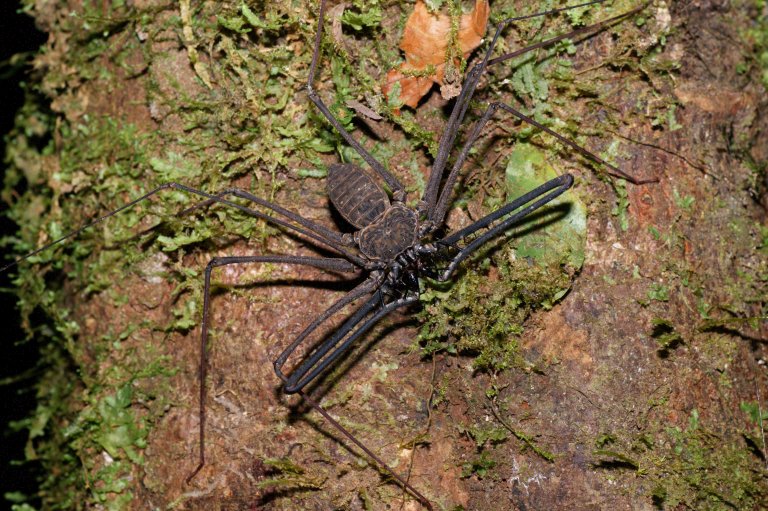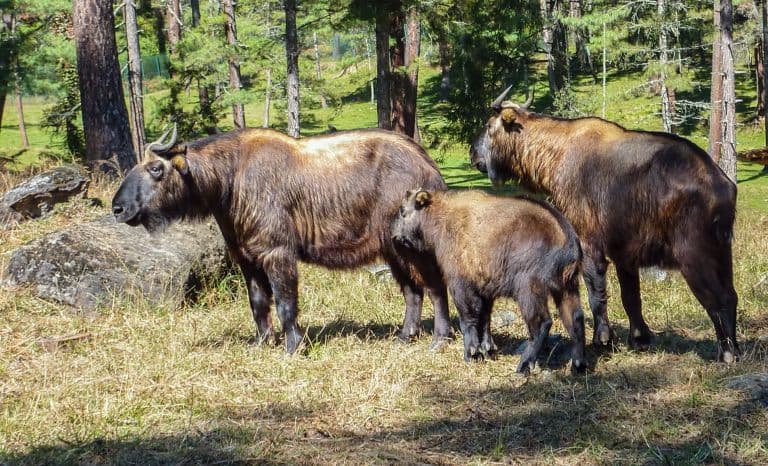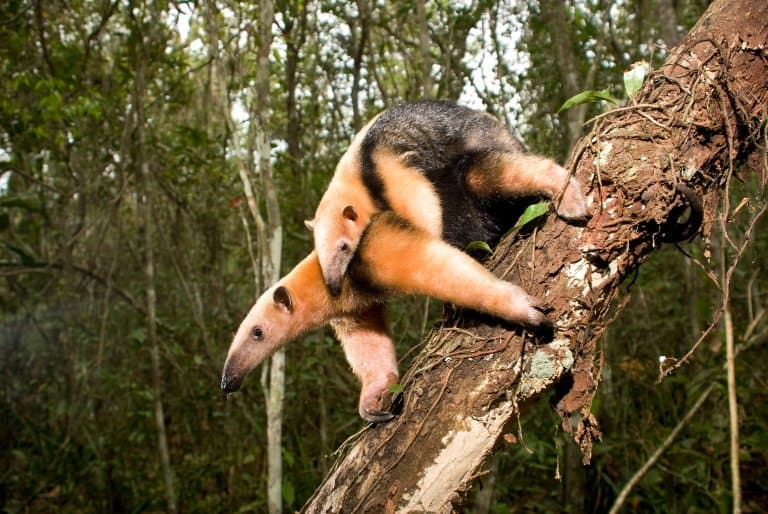This page includes all animals that start with the letter T that we plan to cover on Fact Animal. As we publish new content, each of these animals will be linked to their dedicated profile fact pages.
From Yak to Yeti Crab, read extraordinary facts about animals beginning with the letter T.
T
Tailless Whip Scorpion
Takin
Tamandua
Tamarin
Tang
Tapanuli Orangutan
Tapir
Tarantula Hawk
Tardigrade
Tarpon
Tarsier
Tasmanian Devil
Teacup Poodle
Tasselled Wobbegong
Tenrec
Termite
Tetra
Texas Rat Snake
Textile Cone Snail
Thorny Devil
Thresher Shark
Thylacine
Tibetan Fox
Tiger
Tiger Salamander
Tiger Shark
Tigon
Titan Beetle
Titi Monkey
Toadfish
Tortoise
Toucan
Tree Kangaroo
Trumpeter Swan
Tsetse Fly
Tuatara
Tufted Deer
Tuna
Turkey Vulture
Turkey
Please see our Animal A-Z list for animals that start with different letters.
Animal Names That Start With T
Read on for an overview of each of the animals listed above that begin with the letter T.
Tailless Whip Scorpion
Tailless whip scorpions, despite their name, are not true scorpions and lack a tail or venomous sting. They have long, slender tails resembling whips, which they use to sense their environment. Found in tropical regions, they are nocturnal hunters.

Fun Fact: Despite their frightening appearance, tailless whip scorpions are harmless to humans and are often kept as pets in the exotic pet trade due to their unique appeal.
Takin
Takins are large, heavily built mammals native to mountainous regions of Asia. They have thick, shaggy fur and stout, upturned horns. These robust animals look like something between a goat and a cow and are well-adapted to harsh mountain environments.

Fun Fact: Takins are sometimes called “gnu goats”, but they share a tribe with goats and antelopes and are only more distantly related to cows.
Tamandua
Tamanduas, or lesser anteaters, are semi-arboreal anteaters found in Central and South America. They have long, prehensile tails and elongated snouts equipped with a sticky tongue for extracting insects from tree bark. Tamanduas are nocturnal and solitary animals.

Fun Fact: Like all anteaters, tamanduas have no teeth and their jaws are fused into a straw. Instead, they have special organs called gizzards to break down their food.
Tamarin
Tamarins are small primates native to Central and South America. They are tiny with puffy white facial hair forming moustache-like whiskers. Tamarins live in social groups and primarily feed on fruits, insects, and small vertebrates.
Fun Fact: Tamarins are known for their cooperative breeding strategies, in which older siblings help care for and protect younger offspring.
Tang
Tangs, also known as surgeonfish, are and of around 86 species of beautiful marine fish found in tropical reefs worldwide. They are flattened, oval-shaped, and striped with sharp spines near their tail bases.
Fun Fact: Some tang species, such as the Pacific blue tang, are popular aquarium fish known for their vibrant colours and unique personalities.
Tapanuli Orangutan
The Tapanuli orangutan is the rarest and most endangered orangutan species, found only in the Batang Toru forest of Indonesia. They have long, orange beards and frizzier hair than their Sumatran cousins.
Fun Fact: These are the most arboreal of all great apes, spending the majority of their time in the forest canopy. It’s thought that they evolved this adaptation to avoid tigers on the forest floor.
Tapir
Tapirs are large, herbivorous mammals found in Central and South America and Southeast Asia. They have short, prehensile trunks, which they use to grab leaves, fruits, and aquatic vegetation. Tapirs are excellent swimmers and often retreat to water to escape predators.
Fun Fact: Despite looking a bit like pigs, they’re more closely related to horses and rhinos.
Tarantula Hawk Wasp
Tarantula hawks are large and solitary with distinctive blue-black bodies and bright orange wings. Tarantula hawks are found in hot and arid regions worldwide and are primarily hunters of large spiders.
Fun Fact: The sting of a female tarantula hawk is considered one of the most painful insect stings in the world, with a rating near the top of the Schmidt sting pain index.
Tardigrade
Tardigrades, also known as water bears, are tiny water-dwelling animals known for their incredible resilience to extreme environments. They can survive surprisingly high levels of radiation, temperatures, and even the vacuum of space.
Fun Fact: Tardigrades can enter a state called cryptobiosis, where they lose almost all of their body water and become nearly indestructible.
Tarpon
Tarpons are large, silvery fish found in coastal and brackish waters of Asia, Africa and the Americas. They are prized by anglers for their acrobatic leaps and powerful fights when hooked. Tarpons primarily feed on fish and crustaceans.
Fun Fact: Tarpons possess a unique swim bladder that allows them to breathe air, enabling them to survive in low-oxygen environments and gulp air at the water’s surface.
Tarsier
Tarsiers are small, nocturnal primates found in Southeast Asia. They have large eyes adapted for night vision and elongated hind limbs for leaping through the forest canopy. Tarsiers are skilled insectivores, feeding primarily on small invertebrates.
Fun Fact: Tarsiers have the largest eyes relative to body size of any mammal, each eyeball being approximately the same size as its brain, and can be easily spotted glowing from a distance using a torch.
Tasmanian Devil
Tasmanian devils are iconic carnivorous marsupials found only in Tasmania, Australia. They have powerful jaws and a notoriously ferocious temperament, releasing loud, screeches when disturbed.
Fun Fact: Tasmanian devils are affected by two transmissible cancers known as devil facial tumours 1 and 2. Both are spread by biting and cause tumours on the face or mouth of the animals.
Tasselled Wobbegong
Tasselled wobbegongs are incredible, flat carpet sharks found in the waters of Northern Australia and New Guinea. These rug-like sharks can grow up to almost two meters long and are excellent ambush predators.
Fun Fact: Tasselled wobbegongs are masters of camouflage, with not only coloured but also textured (tasselled) body adaptations to blend with their surroundings.
Teacup Poodle
Teacup poodles are a miniature poodle breed, prized for their small size and playful demeanour. They are intelligent, affectionate dogs and have curly, hypoallergenic coats.
Fun Fact: Teacup poodles were originally bred as companions for nobility and royalty in Europe during the 18th century and would act as hand warmers inside the sleeves of the owners.
Tenrec
Tenrecs are small mammals native to Madagascar and parts of Africa. They come in a lot of sizes, and often look a bit like a mix between hedgehogs, shrews, and porcupines. Tenrecs are primarily insectivorous but may also feed on small vertebrates, fruits, and seeds.
Fun Fact: Tenrecs are incredibly diverse, filling island roles that many more familiar animals never reached. As such their recognizable features come entirely from convergent evolution.
Termite
Termites are social, ant-like insects known for their ability to construct intricate mounds and consume wood. They live in colonies with specialized castes for different tasks and play a fundamental role in their ecosystems.
Fun Fact: Despite looking and behaving like ants, termites are part of the cockroach order and are entirely unrelated.
Tetra
Tetras are small, colourful freshwater fish native to South America. They are popular aquarium fish for their vibrant colours and schooling behaviour. Tetras are omnivorous and thrive in planted aquariums with ample hiding spaces.
Fun Fact: The neon tetra is one of the most popular aquarium fish in the world, and should be kept in groups of at least six. Their lateral stripe appears to change colour in different lights.
Textile Cone Snail
Textile cone snails are predatory marine gastropods found in tropical oceans worldwide. They have beautifully patterned shells and highly venomous harpoon-like radula used to immobilize prey.
Fun Fact: The venom of some textile cone snail species contains compounds that have potential pharmaceutical applications, including in pain relief and treatment for neurological disorders, but they’re also strong enough to kill a person.
Thorny Devil
Found in Australian deserts, Thorny Devils are very spiny lizards with unique adaptations for survival. They have a decoy head on their necks to confuse predators and can change colour based on temperature.
Fun Fact: Thorny Devils can collect water through capillary action using grooves on their skin, channelling the morning dew up to their mouths for drinking.
Thresher Shark
Thresher Sharks are named for their long, whip-like tails, which they use to stun prey. They inhabit open oceans worldwide, primarily feeding on small fish and squid. Their tails are used as a whip to stun shoaling fish to eat.
Fun Fact: Thresher Sharks are capable of breaching the water’s surface, sometimes leaping up to six meters in the air.
Thylacine
The thylacine, or Tasmanian tiger, was a carnivorous marsupial native to Tasmania, Australia. It had a wolf-like appearance with distinctive stripes across its back. Unfortunately, thylacines were declared extinct in the 20th century due to hunting and habitat loss.
Fun Fact: The thylacine was the largest carnivorous marsupial of the modern era, with powerful jaws and seemingly smart, yet very little of its behaviour was scientifically documented.
Tibetan Fox
The Tibetan fox, also known as the sand fox, inhabits the Tibetan Plateau and surrounding regions. It has a golden brown coat to blend with its arid environment and the same sort of unimpressed expression that you commonly see in cats.
Fun Fact: Tibetan foxes have dense fur covering their footpads, providing insulation against the cold ground.
Tiger
Tigers are the largest wild cats in the world, known for their impressive orange coats with black stripes. They inhabit a rapidly decreasing range of habitats across Asia and are apex predators, hunting deer, wild boar, and other large mammals.
Fun Fact: Tigers are powerful swimmers and are known to hunt in water, making them one of the few cat species comfortable in aquatic environments.
Tiger Salamander
Tiger salamanders are large, terrestrial amphibians found in North America. They have bold yellow or olive-green markings on their dark bodies, resembling tiger stripes. Tiger salamanders spend most of their lives underground and emerge to breed in ponds.
Fun Fact: Tiger salamanders are capable of regenerating lost body parts, including limbs and even parts of their retinas, brains and spinal cord.
Tiger Shark
Tiger sharks are large, aggressive predatory sharks found in tropical and temperate oceans worldwide. They are named for their dark vertical stripes that fade with age. Tiger sharks are opportunistic feeders, consuming a wide range of prey, including fish, seals, and even garbage.
Fun Fact: Tiger sharks have a reputation for indiscriminate eating habits and the variety of objects found in their stomachs, including car tyres and licence plates.
Tigon
A tigon is a hybrid cross between a male tiger and a female lion (lioness). They inherit characteristics from both parents, often resembling a smaller version of a tiger with faint lion-like features. Tigon hybrids do not exist in the wild and are only found in captivity.
Fun Fact: Tigons are usually unhealthy animals, bred to attract gawkers at unregulated zoos. For this reason, breeding Tigons is banned in Taiwan.
Titan Beetle
The titan beetle is one of the largest beetles in the world, found in South America’s rainforests. It has a glossy black exoskeleton and formidable mandibles and can grow up to around 16cm long.
Fun Fact: Titan beetles can produce a loud hissing sound by rubbing their abdomen against their wings, serving as a warning to potential predators.
Titi Monkey
Titi monkeys are small primates native to South America’s tropical forests. They have long, fluffy tails and typically live in monogamous pairs or small family groups. Titi monkeys are arboreal, spending most of their time in the forest canopy.
Fun Fact: Titi monkeys are highly social and can be seen in pairs with their tails intertwined in a special hug.
Toadfish
Toadfishes are bottom-dwelling marine fish found in coastal waters worldwide. They have broad, flattened bodies and are known to produce loud, foghorn-like calls using specialized muscles and swim bladders.
Fun Fact: Male toadfishes use vocalizations to attract females for mating, and their calls can be heard for long distances underwater.
Tortoise
Tortoises are terrestrial reptiles with hard, bony shells. They inhabit a variety of habitats worldwide and are primarily herbivorous. Tortoises are long-lived animals, with some species living well over 150 years and growing to huge sizes.
Fun Fact: A group of tortoises is known as a creep.
Toucan
Toucans are brightly colourful, large-billed birds found in tropical forests of Central and South America. They have vibrant plumage and oversized, novelty beaks used for reaching fruits and feeding. Toucans are smart and social birds and are often seen in pairs or small flocks.
Fun Fact: Despite the size of their beaks, toucans are surprisingly lightweight, with air-filled cavities in their bones and bill, reducing their weight for flight.
Tree Kangaroo
Tree kangaroos are marsupials found in the rainforests of Australia, New Guinea, and nearby islands. They are well adapted to arboreal life, with strong limbs for climbing and a long tail for balance. They mostly feed on leaves, fruits, and flowers.
Fun Fact: Tree kangaroos are skilled jumpers. They’re thought to have evolved from terrestrial macropods and retain some of their more familiar cousins’ springiness.
Trumpeter Swan
Trumpeter swans are North America’s largest waterfowl species, named for their resonant trumpet-like calls. These striking birds inhabit freshwater lakes and ponds, migrating south in winter. Trumpeter swans mate for life and often form family groups.
Fun Fact: Trumpeter swans can weigh up to 12 kilograms (26 pounds), making them one of the heaviest flying birds in the world.
Tsetse Fly
Tsetse flies are blood-feeding insects found in sub-Saharan Africa. They are infamous for transmitting trypanosomes, parasites that cause diseases such as sleeping sickness in humans and nagana in animals. Tsetse flies inhabit woodlands and savannas, often near water sources.
Fun Fact: Tsetse flies have an unusual reproductive adaptation called adenotrophic viviparity, where larvae develop internally and are nourished by a milk-like substance secreted by the mother.
Tuatara
Tuatara are reptiles endemic to New Zealand, closely resembling lizards but belonging to a totally distinct lineage. They have unique features like a “third eye” on their forehead and a specialized dentition. Tuatara are nocturnal predators, feeding on insects, spiders, and small vertebrates.
Fun Fact: Tuatara are often considered “living fossils” because they have remained virtually unchanged for over 200 million years, representing one of the oldest surviving reptile orders, the Rhynchocephalia.
Tufted Deer
Tufted deer are small deer species native to the forests of China and Myanmar. They have distinctive tufts of black hair on their ears and elongated canines in males.
Fun Fact: Male tufted deer use their elongated canines for display rather than combat and in place of antlers, which are not present in this species.
Tuna
Tuna are huge, fast-swimming fish found in oceans worldwide. They are highly migratory and prized for their meat. There are at least eight species, including bluefin, yellowfin, and skipjack.
Fun Fact: While tuna are recognized primarily for the tinned food they provide us, these are highly specialized, powerful predators that can grow to 700kg or more.
What Other Animals Begin With ‘T’?
That completes our list of animals that begin with the letter T.
Hopefully you’ve learned a few new ones, but are there any that we’re missing in our list that you would like to see covered?
If so, get in touch. Please see our Animal A-Z list for animals that start with different letters.
